If you’re looking to grow your local business, Local Search Engine Optimisation is a great place to start.
Unlike traditional SEO, Local SEO focuses on optimising your website and content to rank for specific geographic terms such as cities, states, or countries. Examples include “plumbers Singapore,” “accountants New York” or “SEO consultant Singapore.”
This may be a good way to grow and attract more customers to your business and boost your bottom line.
In this guide, you will learn thoroughly everything there is to know about Local SEO.
We’ll cover everything from the basics to more advanced techniques like citations and local link building. Let’s get started!
Chapter 1: Local SEO Fundamentals
Before starting to optimise your website for local SEO, it’s crucial to comprehend the fundamentals.
In this chapter, we’ll discuss what Local SEO is and how it works. We’ll also talk about some key factors influencing your local rankings.
What is Local Search Engine Optimisation?
A subset of search engine optimisation (SEO) called Local Search Engine Optimisation helps you to market your products and services to local prospects and customers.
It involves optimising your website and online content for the specific geographic area you serve. For instance, you might wish to optimise your website for local keywords like “restaurants in Los Angeles” or “Los Angeles restaurants” if you own a restaurant in that city.
Why is Local Search Engine Optimisation Important?
There are a few reasons why Local Search Optimisation can be beneficial for your local business. First, it can aid in drawing in more customers to your area.
If your website is optimised for local keywords, it will appear higher in search results when people search for those keywords.
In turn, this may result in an increase in website traffic and, ultimately, sales.
Second, Local Search Engine Optimisation can help you build trust and credibility with potential customers.
When your website appears in local search results, it shows that you are a relevant and trustworthy local business.
This is particularly useful if your business is new or if you still don’t have a strong presence online.
Finally, Local Search Engine Optimisation can help you stand out from your competition.
If your competitors are not optimising their websites for local search, you could have a competitive advantage.
Chapter 2: Local SEO Keyword Research
The selection of the appropriate keywords is one of the most crucial elements of local SEO. Keywords are the words or phrases people use when searching for businesses like yours.
In this chapter, we will discuss where to find your local keywords.
Look for Ideas in “SiL” (Service in Locations) Searches
SiL or Service in Location searches is a great way to come up with ideas for Local SEO keywords.
SiL searches are simple searches that include service and a location, such as “pizza delivery in Perth” or “plumbers in Adelaide.”
To find SiL search ideas, start by brainstorming a list of services your local business offers. Then, add a location to each service to create a SiL search.
For example, if you offer lawn care services, some SiL searches might be “lawn care New South Wales” or “lawn care NSW.”
To generate SiL search ideas, you can also use tools for keyword research like SEMrush and Google Keyword Planner.
Simply enter the service and a location into the tool, and it will generate a list of related keywords.
Look for Ideas in Google Suggestions
Google Suggestions is another great way to find Local SEO keywords.
To find Local Search Engine Optimization keywords with Google Suggestions, simply start typing a search into Google and see what suggestions appear.
In Google, for instance, you might find suggestions like “pizza near me” or “pizza delivery” if you type in “pizza.”
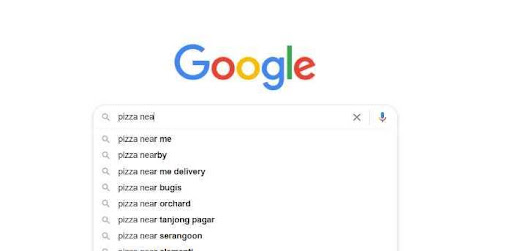
To create a list of Google Suggestions for your target keywords, you may also utilise tools like KeywordTool.io.
Look for Ideas in your Competitor’s Keywords
Obtaining Local SEO keywords from your competitors might be quite beneficial. Create a list of your competitors in order to find competitor keywords.
Then, to discover the terms that your competitors are ranking for, use a keyword research tool like Google Keyword Planner or SEMrush.
You could use Google Keyword Planner, for instance, if you’re a plumber in Los Angeles, to identify the phrases that your competitors are ranking for.
You can also use SEMrush or Ahrefs to find competitor keywords.
Simply enter your competitor’s website into the tool, which will generate a list of related keywords.
Chapter 3: Local Keywords Optimisation
Now that you are done with Local SEO Keyword Research in the previous chapter, it is important to know where to place your local keywords for an effective Local SEO strategy.
In this chapter, we will cover where to include the local keywords you found in your keyword research.
Include local keywords in your title tags and meta descriptions.
Once you have a list of Local SEO keywords, you can start using them on your website. A great place to start is in your title tags and meta descriptions.
Your title tag is the text that appears in the search results when people find your website. It should be short and descriptive and include your target keyword.
For instance, your title tag can be “Adelaide Plumber | ABC Plumbing” if you’re a plumber in Los Angeles.
In the search results, the material that follows your title tag is known as your meta description. It should contain your target keyword and be around 155 characters long.
For example, it might be “ABC Plumbing is a Los Angeles-based plumbing company that offers residential and commercial plumbing services.”
By including these keywords, you’re making your website more relevant to what customers might search for. This increases your chances of appearing in search results.
Include local keywords in your content.
Once you have a list of Local SEO keywords, you should start using them to create local content. Including local keywords in the blog posts and articles on your website is an excellent way to do this.
If you’re a Sydney real estate agent, you could write an article on “purchasing a home in Sydney,” and if you’re a plumber in Perth, you could create a blog post about “plumbing tips for Perth homeowners.”
Another important thing to note is the importance of putting your keywords in your header tags. Your main keyword should be included in your H1 tag and other related keywords can be distributed to your H2’s and H3 tags.
You may make your website appear better in local searches for those keywords by incorporating local keywords into your content.
Include local keywords in your business listings.
Another great way to use Local SEO keywords is in your business listings. When you create a listing for your business on directories like Google My Business and Yelp, make sure to include local keywords in your listing.
For instance, you might use keywords like “Los Angeles plumber” or “plumbing services in Los Angeles” if you’re a plumber in that city.
When customers search for local keywords, you may help your listing appear higher in search results by incorporating local keywords into your company listings.
Chapter 4: Search Engines Listing
The most crucial part of Local Search Engine Optimisation is your search engine listing.
This is because it’s one of the first places potential customers will look when searching for a business like yours.
You can have two types of listings on search engines: organic and paid.
Organic listings are the results that come up naturally when someone searches for something on a search engine.
These listings are usually based on the relevancy of the website to the person’s search.
On the other hand, Paid listings are results that businesses have paid to appear at the top of a search engine’s results.
These listings are not necessarily more relevant than organic listings but are more visible.
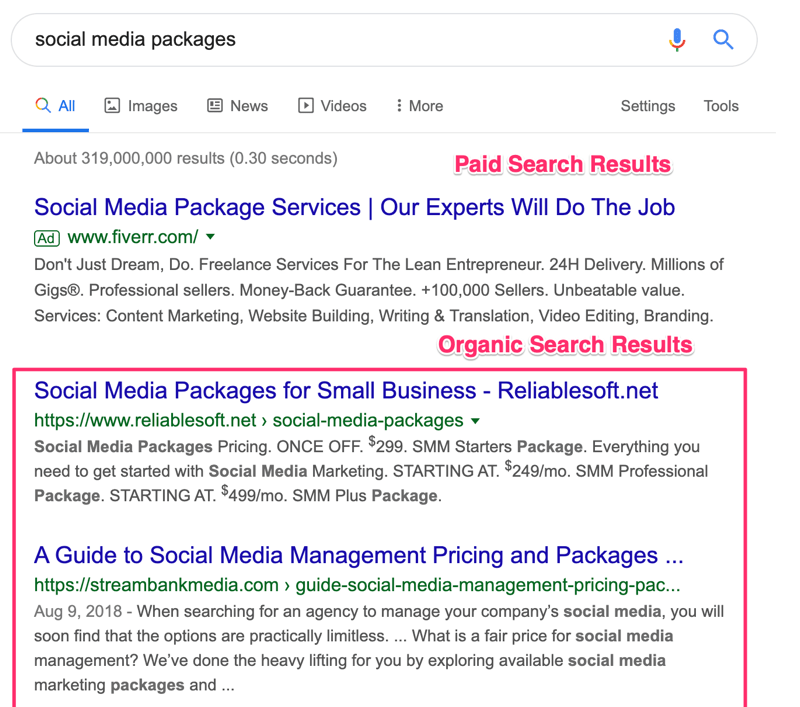
To improve your search engine listing, you should focus on both your organic and paid listings.
List of paid listings:
Paying for advertisements on search engines like Google, Yahoo!, and Bing
A budget for your advertising campaigns, paying for social media ads
Creating keyword-rich ads
Google My Business
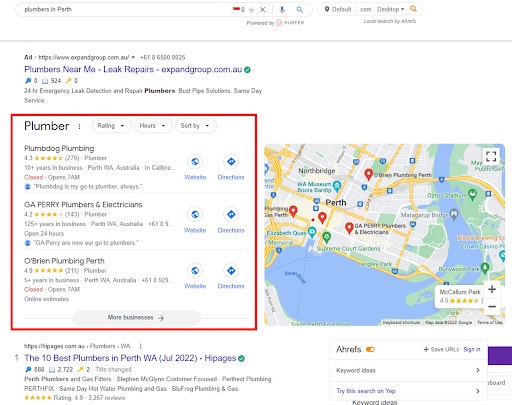
Using the service Google My Business, you can manage and improve your Google Business Profile. It can be accessed, modified, managed, and improved by setting up a Google My Business account.
Google refers to your Google business listing as “your business profile.” Google Maps and Google Search’s local results both display business profiles.
Setting Up Google My Business Profile
Step 1: Sign in
If you already have a Google account, you are instantly signed into Google Business Profile Manager. If not, sign in with your Google account credentials or make a new account.
Step 2: Add your business
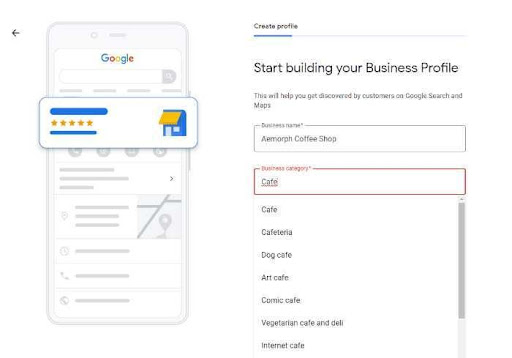
Type in your business’ name. If your company’s name does not appear in the drop-down menu, click Add your business to Google. After choosing the appropriate business category for your business, click Next.
Step 3: Enter your address
If your business has a physical location that customers may visit, select Yes. Include your company’s address after that.
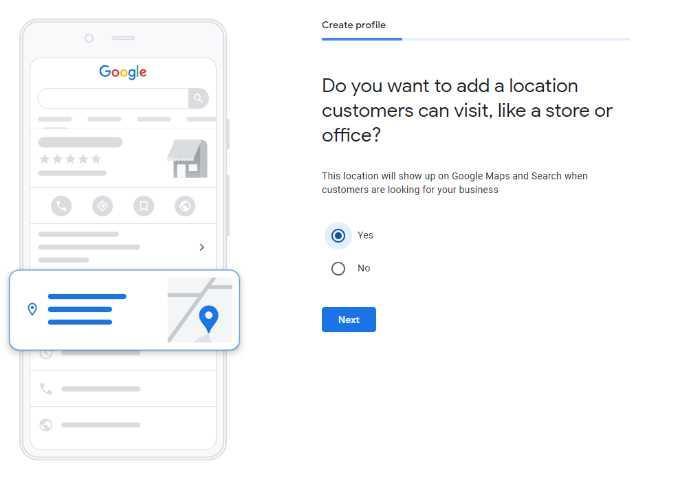
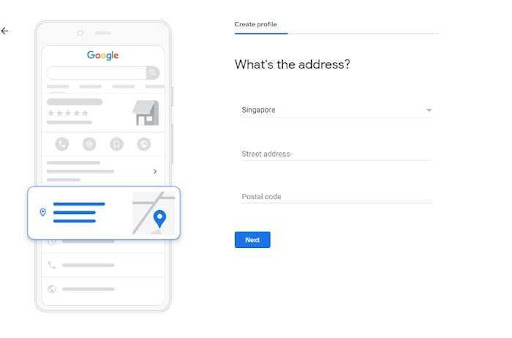
;
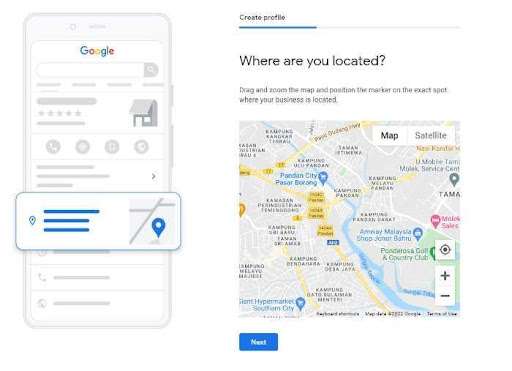
You may also be requested to place a marker on Google Map to indicate the location.
If your business doesn’t have a physical address that customers can visit but offers in-person services or delivery, you can designate your service areas. Then press Next.
Click Add your business to Google if your company isn’t listed in the drop-down menu.
Then, after selecting the appropriate category for your firm, click Next.
Step 4: Enter your contact information
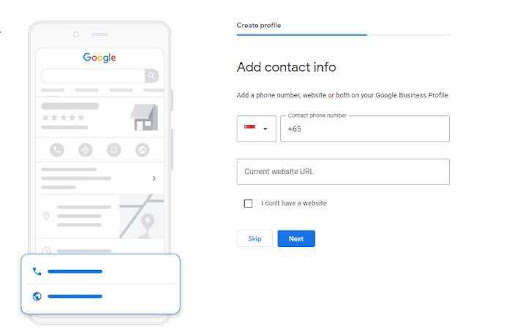
Customers can contact you by entering your business phone number and website address. You do not need to enter a phone number if you do not want to be contacted by phone.
Once you’ve completed entering your information, click Next.
Step 5: Verify your business
Enter your exact physical address. This data is not made public or shown on your Google Business Profile; it is only required to verify your business.
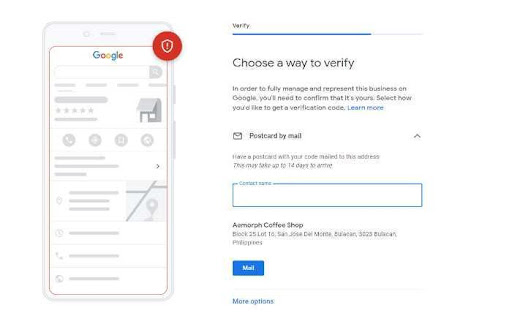
After entering your address, click Next. The appropriate alternatives for account verification will be provided to you. Businesses with physical locations will get a postcard in the mail to verify their address. Service-area businesses can be verified using an email address.
On the following screen, enter your five-digit code (or go to https://business.google.com/) and select Verify or Verify business.
A confirmation screen letting you know that your identity has been validated will appear. Click Next on that screen.
Step 6: Optimise your profile
Give details about your company, including a description, business hours, contact information, and images. Afterwards, select Continue.
Bing Places for Business
With the help of the free Bing Places for Business service, businesses can take control of the accuracy of the information that customers see about them by adding new Local Listings or claiming ones that already exist.
Setting Up Bing Places for Business
Step 1: Claim your listing
To get started, you must claim your business on Bing. You can do this by going to the URL (https://www.bingplaces.com/) and claiming your listing.
Alternatively, if your company isn’t already listed, you can visit the listing page and choose to add it.
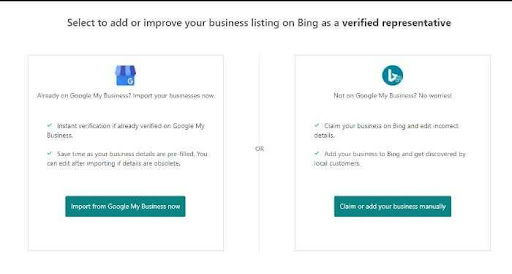
Step 2: Complete your listing profile
After you have claimed your listing, you will be able to log in and complete your profile.
Be sure to include images of your business and services, hours of operation, services offered, and a list of the different methods customers can contact you.
You can also add coupons and special offers to encourage customers to visit your business.
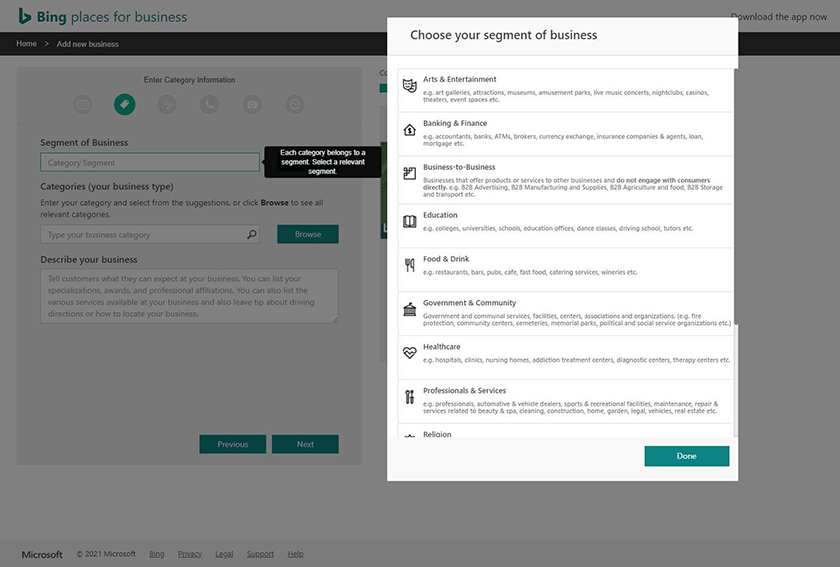
Step 3: Verify your listing
Verify your listing to protect it from unauthorised alterations. You can validate your listings by obtaining a PIN at your business address, phone number, or email address. All businesses must disclose a valid address. However, some can hide their address from search results.
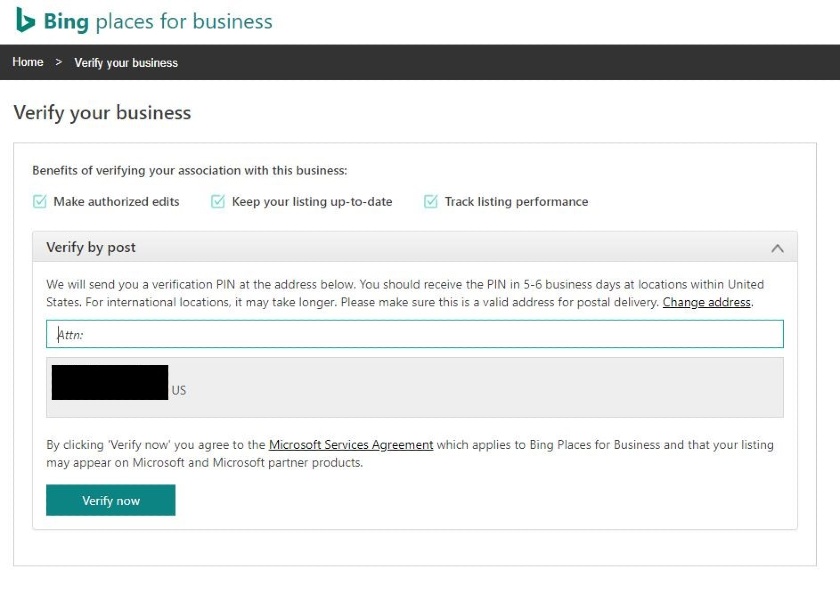
Chapter 5: NAP Citations
Name, Address, and Phone Number, or NAP are details that must be consistent across the internet for Google to accurately match searchers with local businesses.
Citations are instances where your NAP is mentioned on other websites. The more citations you receive from reliable websites, the better.
There are two types of citations:
Structured: These include your NAP in a consistent format, typically on a business directory listing or business profile page.
Unstructured: These are mentions of your business name without including your NAP information. An example would be an article that mentions your company but doesn’t include your contact details.
It’s important to have both types of citations, but structured citations are more valuable because they’re consistent and easier for Google to find.
Why are NAP Citations important?
NAP citations are important because they help Google match searchers with local businesses.
It will be simpler for Google to find your business and display it to those searching for what you offer if your NAP is consistent across the internet.
Citations also help improve your local search rankings.
The more citations you receive from reliable websites, the better. The more citations you have, the better your chances are of appearing in local search results because Google uses citations as an indicator of reliability and relevance.
How to perform a NAP Citation audit?
Performing a NAP citation audit is simple.
First, you need to compile a list of all the places where your business is listed online. This includes directories, social media profiles, and any other website that mentions your business.
Once you have a list of all the places where your business is mentioned, you need to check each one to make sure that your NAP information is correct.
If there are any errors, you need to update the business listing with the correct information.
To track your citations and make sure they are accurate, you may use a service tool like Moz Local.
How to find Nap Citation?
There are a few ways to find NAP citations.
The first is to do a Google search for your business name and look at the results. (You can do this to other search engines as well.) Any website that appears in the search results is likely to have a citation for your business.
A tool like Moz Local can be used to help you track your citations and ensure that they’re accurate.
Another way to find NAP citations is to search for directories in your industry and submit your business information to them. This is a good way to get high-quality citations from websites that are relevant to your business.
What are the best NAP Citation sources?
The best NAP citation sources are websites that are relevant to your business and have a high degree of trustworthiness.
Some examples of high-quality NAP citation sources include directories like Yelp, Foursquare, and the Better Business Bureau.
Submitting your business information to these websites is an excellent way to get high-quality citations that will help improve your local search rankings.
What are some common NAP Citation mistakes?
There are a few common NAP citation mistakes that business owners make.
The first is listing their business information in directories that are not relevant to their industry. This can hurt your local SEO because its local ranking signals to Google that your business is not relevant to the directory’s audience.
Another frequent error is not adding all of the information required by Google to authenticate your business. This includes your business name, address, and phone number. If you’re missing any of this information, then your citation will not be as valuable to Google.
Finally, some businesses make the mistake of using multiple listings for their business. This can also hurt your local SEO because you’re sending mixed signals to the search engine about your location and asking whether which one is your real location.
Avoid these typical NAP citation errors if you wish to optimise your local SEO.
What are some tips for optimising NAP citations?
There are a few things you can do to optimise your NAP citations and improve your local SEO.
The first is to ensure that your NAP information is consistent across all your listings. Your business name, address, and phone number should be the same on every website where it’s listed.
Another thing you can do to optimise your NAP citations is to add additional information to them.
This includes things like your business hours, website URL, and a description of your business. Adding this information makes your citations more valuable to Google and can help improve your local search rankings.
Chapter 6: Local Link Building
How to create local link building in Local Potential Business Partners?
There are a few things you can do to create local link building in Local Potential Business Partners.
The first is to identify websites that are relevant to your business and offer something of value to their local audience. This could be a blog post, an article, or even just a directory listing.
The next step is to contact those websites you’ve identified as potential partners and offer your content. To allow people to see what you have to offer, be sure to provide a link to your website.
Finally, you’ll need to follow up with the websites after you’ve submitted your content. This helps to ensure that they’re happy with what you’ve provided and will continue to link back to your website.
How to create local link building in Local Chambers of Commerce?
A local Chamber of Commerce is one of the most accessible links you’re ever going to get.
Similar to Local Potential Business Partners, the first step is to identify websites relevant to your business and offer something of value to their audience.
Once you’ve identified potential partner websites, the next step is to reach out to them and offer your content. Include a link to your website so that they can learn more about what you have to offer.
Finally, after you’ve submitted your content, you’ll need to follow up with the websites. This helps to ensure that they are satisfied with your services and will continue to link to you.
How to create local link building in Local Events?
You can find local events relevant to your business by searching online or by asking around in your community.
After you’ve identified a few possible events, reach out to the organisers and pitch your content.
This might be a directory listing, a blog entry, or an article on the event. To allow people to see what you have to offer, be sure to provide a link to your website.
Finally, you’ll need to follow up with the event organisers after you’ve submitted your content. This helps to ensure that they’re happy with what you’ve provided and will continue to link back to your website.
By following these strategies, you can create local link-building opportunities and improve your local SEO.
Chapter 7: Continuous Activities
Why is a continuous activity a must for Local SEO?
Local SEO is all about ensuring your business appears in relevant search results for local customers. To achieve this, it is essential to have continuous activity in your Local SEO campaign.
By taking continuous action on your Local SEO campaign, your business will appear prominently in search results, making it more likely that local customers will find and patronise your business.
To do this, we have a few tasks to complete to maintain ongoing activity for Local SEO.
Keeping Active in the Local Business Listings
Making sure that your business is listed in as many local directories as you can is the first step. This helps to ensure that your business is visible to potential customers.
You can also use social media to stay active and engaged with your potential customers. This could include creating a Facebook page for your business, posting regular updates on Twitter, or even writing a blog.
Most importantly, you have to make sure you respond to customer reviews. Thank them for positive reviews and properly address any negative comments, giving them solutions to their problems and reassuring them that you are there to help them.
Regular Content Publishing
Regular content publication is one of the finest strategies to stay active and involved with your potential clients. This might include articles, blog posts, or even video material.
This helps to demonstrate to potential customers that you are an expert in your field and are constantly working to offer insightful information. Additionally, it aids in maintaining your website’s relevance and freshness, which is crucial for local SEO.
Engaging with Customers
Finally, it’s important to remember that engagement is key. This means responding to positive customer reviews, answering questions, and even interacting with customers on social media.
Optimise Meta Description
Additionally, you want to add relevant keywords to your website’s meta descriptions. This makes it more likely that people looking for businesses like yours will find your website.
Chapter 8: Local SEO FAQs
How do you perform Local SEO?
Local SEO can be done in a few different ways.
First, you need to make sure that your website is optimised for local keywords. This includes relevant keywords in your website’s content and meta descriptions.
Additionally, you have to make sure that your company is listed in as many local directories as you can. This makes it more likely that potential customers will find your company while looking for similar businesses.
Finally, you should engage with potential customers on social media and other platforms.
By doing this, you can gain the reputation and confidence of potential customers.
What distinguishes local SEO from general SEO?
The difference between SEO and local SEO is that local SEO is specifically designed to improve your visibility in local search results. This implies that when potential clients look for businesses like yours in your area, they are more likely to locate yours.
SEO is a broader term that includes both local and non-local optimisation techniques.
Can Local SEO be done without a physical location?
No, you cannot do local SEO without a physical location.
This is due to the fact that getting your company listed in as many local directories as you can is one of the essential elements of local SEO. You must have a physical address for your company in order to achieve this.
Do I need to be on all social media platforms?
No, you are not required to use every social media site. On the other hand, it’s crucial to be involved and active on the platforms you use.
This could include posting regular updates, responding to customer reviews, and interacting with potential customers.
What are some common Local SEO mistakes?
Some common local SEO mistakes are without relevant keywords in your website’s content, title tags and meta descriptions, not being listed in enough local directories, and not being active and engaged on social media.
You may enhance your local SEO efforts by steering away from these frequent errors.
What’s the best way to get started with Local SEO?
The best way to get started with local SEO is to make sure that your website is optimised for local keywords.
This involves using relevant keywords in the content and meta descriptions of your website.
Additionally, you have to make sure that your business is listed in as many local directories as you can.
Improve your search engine listing as well. When looking for a business like yours, potential clients will usually start their search there.
Finally, interact with potential clients on social media and other platforms. By doing this, you can gain the reputation and confidence of potential customers.
What is Local SEO marketing?
Local SEO marketing or local business marketing is the process of optimising your local business website and online web presence for local keywords.
This involves ensuring that your website is optimised for local keywords, that your company is listed in as many local directories as possible and that you are interacting with potential clients on social media and other platforms.
Is Local SEO paid?
Local SEO is not paid. However, you may need to invest in some tools and resources to help with your local SEO efforts.
For example, you may want to consider investing in a tool like Moz Local to help optimise your website and listings for local keywords.
To assist with your local SEO plan, you might also wish to engage an SEO specialist or agency.
What is the future of Local SEO?
The future of local SEO looks promising.
We’ll probably see even more creativity and development in this field as more businesses concentrate on enhancing their local SEO. Thus, companies who engage in local SEO now will be well-positioned to seize possibilities in the future.
Local SEO is a crucial component of every company’s marketing plan.
You may increase your visibility in local search results by local keyword optimising your website and online presence. For your business, this could result in an increase in organic traffic and sales.
How do I get my local citations indexed?
You may index your local citations in a few different ways.
You can manually add your website and business listings to local directories. Alternatively, you may automate the process by using a programme like Moz Local.
To assist with your local SEO plan, you can also employ an SEO specialist or agency.
Conclusion
Your exposure to local search results can be increased with the use of local SEO and a strong marketing strategy.
You can increase organic traffic and sales for your business by optimising your website and online presence for local keywords.
Now is the perfect time to start concentrating on local SEO.
Do you have any questions about local SEO? Leave a comment below and let us know. We’re always happy to help!




